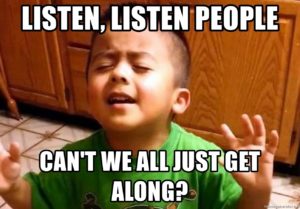 You can have the talent. You can have the donors. You can have a great cause and even a great structure and process. But if don’t have the goodwill, cooperation and support of all the others in your organization, your major gift fundraising efforts will fail.
You can have the talent. You can have the donors. You can have a great cause and even a great structure and process. But if don’t have the goodwill, cooperation and support of all the others in your organization, your major gift fundraising efforts will fail.
This is why Jeff and I are always talking and writing about getting program, finance, HR and all the other departments/divisions, including other efforts in development, on board with what you are doing. (We even wrote a White Paper on the topic.)
Believe me, they do not understand what you do. You might think they do. They don’t.
Several weeks ago I ran into a situation where the program leader just could not get through his head that the area he was leading was the product the MGO was “selling,” and that there was a critical connection between what he did and the ability of the MGO to secure funding from a donor.
“Look, Richard,” he said. “My primary task is to help this organization deliver on our program and mission promise. I do not have time and, frankly, interest, in figuring out what the donor needs.”
Wham! Knock me in the head with a hammer. Really?
This good man is totally unaware that the very money he is using to DO the program comes from donors of all types: individuals, foundations, government, business, etc. And since he is unaware, he cannot – and will not – have time to deliver the help that assures his continued financing.
This is the same story with finance. “Why do I have to provide that information? We do not do it that way! Why is that needed? etc.” Total blindness to what donors need.
Or HR, on the subject of hiring or compensation or time in the office, etc. They do not understand how it works.
Even some development directors don’t understand. Listen to this statement a development director for a $40 million dollar southwestern non-profit told me: “Look. These MGOs are really not delivering value to the organization. All the donors they are working with come out of direct mail. All you have done is move the money from direct mail to major gifts. That is why I am suggesting we cancel the program.”
What!?? Are you the most ignorant person on the face of the earth? Seriously. I am not usually into name-calling, but this statement was so ill-informed, so utterly stupid and so unprofessional that I could hardly stand to be in the same room with this gentleman.
Of course, the donors are qualified out of direct mail or direct marketing. Where does this good person think they come from? Of course, the money that has come in from those donors in the past has moved to major gifts. But here is the part he is missing. Had those donors stayed in direct marketing, their contributed value would have dropped, in this case, 46% through value attrition. Now, under the MGOs’ care, the value lost will be 9%. And there will be new gifts and new revenue coming in. That is how a major gift program works.
But this good man does not understand that. He is intelligent. He is smart. But he is totally ignorant about how the economics of major gifts fundraising works. And that, my friend, is why he will not cooperate or support his MGOs and the major gift program, even though he is the head of the development effort!
Isn’t that amazing? Almost every day (even weekends), Jeff and I get some information from our team that has us saying to each other, “can you believe that?” And no, we can’t. It is truly amazing.
So – and this is the tough part, because you already have so much to do with your donors – so, you must commit time to helping those around you (inside the organization) to understand and appreciate how major gifts works. Because if you don’t, you will not be successful in your job.
Here’s what you should do:
- Get it clearly in your head that even though you have the right talent, the right structure, the right process, the right donors and the right program you must spend time educating and informing those around you.
- Get close to the decision makers in program, finance, HR and any other major support systems. By close, I mean, go to lunch, be with them, understand their world and help them understand yours.
- With program, help them understand you need three things: you need program info packaged to match donor interests and passions; you need to be able to take donors right into the program scene so they can experience it; and you need outcome, proof of performance information to pass to donors so that they know that their giving has made a difference.
- With finance you need three basic things – you need financial information that matches what program gives you, so you can create offers. This is both a front-end activity (creating the offer) and a back-end activity (reporting on what has been done). Those are the first two things. And you need them to understand how the economics of major gifts works. This is critical so that they can grasp and support what you are doing.
- Get with marketing and communications so that they understand how major gifts works and what you need. This is critical. Believe me, these people often do not understand major gifts, the use of language, the psychology and messaging of it, etc. You must spend time with them to educate and inform, so you get the right materials and collateral from them.
- Stay in touch with your top leadership, educating and informing about what I’ve covered here. Again, most top leadership does not understand how major gifts works, which is why, if you can persuade them to do it, they should attend our Major Gift Academy course on the Economics of Major Gift Fundraising, to get a firm intellectual grasp on the topic. Your top finance person should also go to this course.
I know this is a lot. And maybe your manager (if he or she is enlightened) can do most of this work. All I am saying is that it needs to be done, which is why Jeff and I include this topic in any conversation about structure.
I’ve decided to add one more blog to this series – the next one – to wrap up the whole discussion we are having on major gift structure. See you then.
Richard
Read the whole series on MG Organizational Structure:
- What’s Wrong
- The Right Context
- The Major Gift Pipeline
- The Four Main Things
- Can’t We All Get Along? (this post)
- Reengineer to be Donor-Facing





Julie, you are right. The entire institution has to have a culture of philanthropy that understands the important role of the donor and supports those working with them.